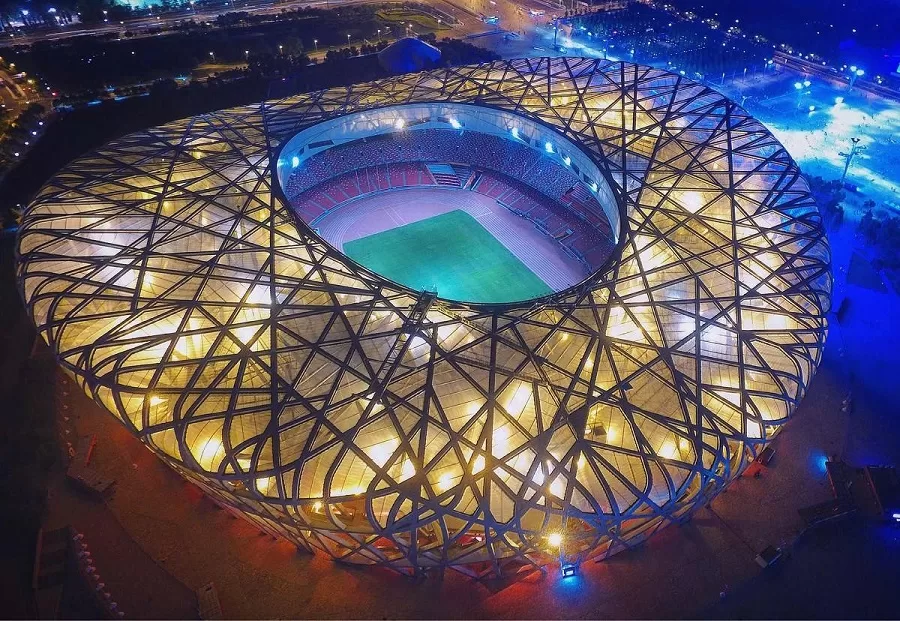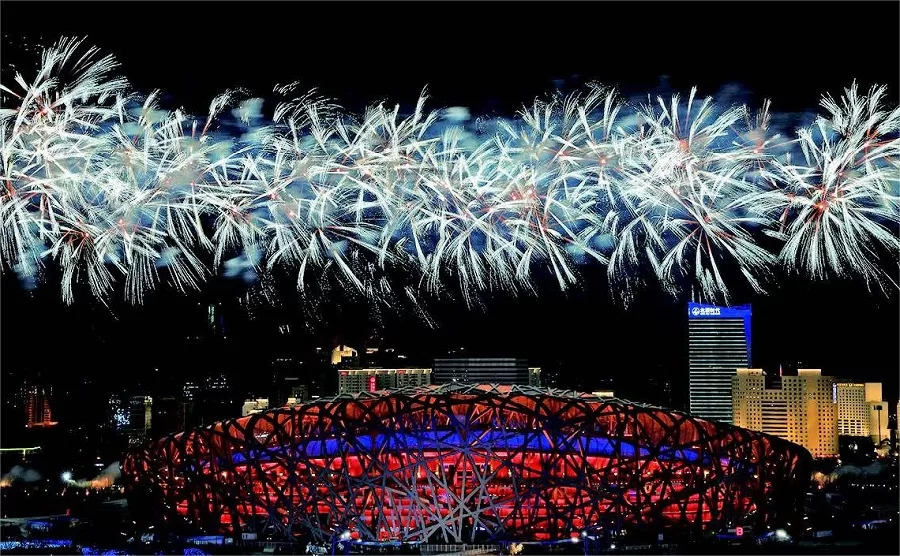Beijing National Stadium (北京国家体育馆), also known as the Bird’s Nest (鸟巢), is a world-famous stadium located in the heart of Beijing, China. It was built for the 2008 Summer Olympics and Paralympics and is one of the largest and most iconic sports venues in the world.
Designed by Swiss architects Jacques Herzog and Pierre de Meuron, along with Chinese architect Li Xinggang, the stadium’s unique and intricate design resembles a bird’s nest, hence its nickname. The stadium’s exterior is made up of a web of steel beams that intertwine to form a complex lattice structure.
The stadium has a seating capacity of 80,000 and was the main venue for the 2008 Summer Olympics, hosting the opening and closing ceremonies, as well as athletics events. It has also hosted a variety of other events, including concerts, cultural performances, and international sporting events.
Since its construction, the stadium has become a symbol of modern China and has attracted millions of visitors from around the world. It is a must-see destination for anyone visiting Beijing and is a testament to the country’s commitment to creating world-class infrastructure and hosting international events.
Table of Contents
- Basic Information
- Location and Transportation
- Highlights of Beijing National Stadium
- Vlog about Beijing National Stadium
- FQ&A about Beijing National Stadium
- Useful Tips Summarized from Reviews
- Explore Beijing Like A Local
Basic Information
| website | https://www.n-s.cn/ |
| Estimated Length of Tour | About 1 Hour |
| Opening Hours | 10.00 – 22.00; Last admission: 21.00 |
| Ticket Price | Admission: 80 RMB Admission + Sky corridor: 100 RMB |
| Telephone Number | 0086-400-600-2008 |
Location and Transportation
Beijing National Stadium is located in the Chaoyang District of Beijing, China. The surrounding area of the stadium is known as the Olympic Green, a large park featuring many other sports venues, including the Observation Tower and the National Aquatics Center, also known as the “Water Cube,” and the National Indoor Stadium. You can get there in various ways:
Bus: Take bus 82, 419, 538, or 645, get off at National Stadium East (国家体育场东), and the stadium will be right to your west.
Subway: Take subway line 8, get off at Olympic Center Station (奥体中心站), and walk about 200 meters to the north to reach the stadium.
Highlights of Beijing National Stadium
Unique Architecture

The architecture style of the Beijing National Stadium is a blend of modern and traditional elements, with a focus on innovation and functionality. The stadium’s design is influenced by the principles of deconstructivism, a postmodern architectural style that emphasizes fragmentation, non-linear shapes, and a sense of dislocation. The use of steel beams arranged in a complex web-like pattern, the irregular shape of the stadium, and the translucent membrane of ETFE all reflect this deconstructivist principle. However, the stadium also draws inspiration from traditional Chinese ceramics, which are known for their intricate and delicate designs. The result is a unique and iconic structure that seamlessly blends modern and traditional aesthetics.
Impressive Size

The Beijing National Stadium is an impressive feat of engineering and architecture with a massive size. The stadium’s seating capacity is 80,000, making it one of the largest stadiums in the world. It covers a total area of 258,000 square meters, with a total construction cost of around $423 million USD. The steel structure of the stadium weighs over 42,000 tons and is supported by over 10,000 steel beams. The stadium’s roof is 68 meters high, and the tallest point of the structure reaches 80 meters. The sheer size of the Bird’s Nest is a testament to the ambition and engineering prowess of its designers and builders.
Spectacular Lighting

The lighting of the Beijing National Stadium is a remarkable feature, with an innovative LED lighting system that illuminates the stadium in various colors and patterns. The design uses advanced technology to create stunning visual effects, including dynamic color-changing effects, graphics, and animations. It is often used for special events, such as concerts and sports competitions, and adds to the overall aesthetic appeal of the stadium
Historical Significance

The Beijing National Stadium is a significant symbol of China’s modernization and growth. Its construction marked a significant investment in China’s infrastructure and was intended to showcase the country’s modernization and economic development to the world. The stadium’s unique design, which resembles a bird’s nest, was the result of a collaboration between Chinese and international architects, highlighting China’s openness to foreign ideas and cooperation. Today, the stadium continues to be a source of pride for the Chinese people and a reminder of the country’s achievements on the global stage.
Vlog about Beijing National Stadium
FQ&A about Beijing National Stadium
What is the Beijing National Stadium used for now?
Since the conclusion of the 2008 Olympics, the Beijing National Stadium has been used for a variety of purposes. It is still used for major sporting events such as football (soccer) matches, as well as athletics and other sports competitions. The stadium has hosted a number of high-profile events, including the 2015 World Championships in Athletics and the 2019 IAAF World Athletics Championships.
In addition to sporting events, the Bird’s Nest has also been used for cultural and entertainment purposes. It has been the site of numerous concerts, festivals, and performances, with artists such as Beyoncé, Lady Gaga, and Coldplay having performed there. The stadium has also been used for public events, such as the Beijing International Automotive Exhibition.
The structure of the Beijing National Stadium
The Beijing National Stadium is a massive steel structure covering 258,000 square meters with a seating capacity of 91,000. Its unique lattice design, resembling a bird’s nest, consists of thousands of interwoven steel beams, creating a striking visual effect.
The beams were prefabricated and assembled on-site using cranes and hydraulic lifts, reducing construction time and environmental impact. The roof features two layers of steel beams with a translucent material in between, allowing natural light during the day and an illuminated display at night. Inside, the stadium has three seating levels arranged in a bowl shape, providing excellent views. The playing field, made of natural grass, is surrounded by a running track.
What is the Beijing National Stadium made of?
The Bird’s Nest, is primarily made of steel, forming a complex lattice structure with 24 trussed columns. The steel trusses are coated with fireproof material for safety.
Concrete was used for the lower bowl and outer walls, providing strength to withstand Beijing’s weather and seismic activity. The outer surface is covered with ETFE, a lightweight, transparent polymer that allows natural light while offering protection. This material also gives the stadium its dynamic appearance, changing color with sunlight.
Other materials include aluminum and glass. The roof is supported by steel cables anchored to an aluminum ring beam, which also holds the stadium’s lighting system. These materials together create the Bird’s Nest’s iconic design and structural durability.
Useful Tips Summarized from Reviews
Photo Opportunities: Embrace the experience of Olympic champions by posing with gold medals, holding bouquets of flowers, and draping yourself in the national flag for a photo. Photos are available for purchase at 10 yuan per print.
Exploring the Interior: While the interior of the Bird’s Nest may not offer much to see compared to other sports arenas, it’s still an iconic venue worth visiting. Consider taking a quick stroll inside for a firsthand look at the architecture and ambiance.
Night Illumination: Witness the beauty of the Bird’s Nest illuminated at night. The lights come on at 19:40 during summer and 18:00 during winter. The nighttime view offers a different perspective and can be more visually stunning than during the day.
Luggage Storage: If you have luggage or bags that you don’t want to carry around, take advantage of the luggage storage service. You can deposit your belongings between 10:00 and 18:00, and retrieve them between 10:30 and 19:00. The storage area is located at the west entrance of the National Stadium (Bird’s Nest), near the visitor service center.



With summer approaching and various concerts taking place, the nights at the Bird’s Nest (鸟巢) have become very lively.
I just passed by the Bird’s Nest, and the night view is still stunning! As soon as the lights come on, the atmosphere is absolutely vibrant.
The Bird’s Nest is even more beautiful at night than during the day, with singers, candy sculptors, and lively night market stalls… it’s quite bustling!